Home » Minerals » Diamond » Brown Diamonds
Brown Diamonds
Also known as chocolate, champagne or cognac diamonds
Author: Hobart M. King, PhD, GIA Graduate Gemologist
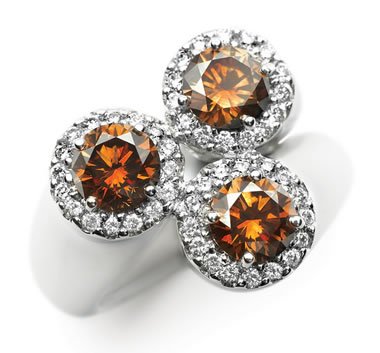
Beautiful Brown Diamonds: Three cognac-colored diamonds from Rio Tinto's Argyle mine in Western Australia clearly demonstrate the beauty of brown diamonds. Image Copyright 2016 Rio Tinto.
What Are Brown Diamonds?
Brown diamonds are diamonds with a brown bodycolor. As recently as the 1980s, most brown diamonds were crushed to make abrasive granules. Today they are used in new jewelry designs that take advantage of their sparkle and their attractive brown color. Brown colors named chocolate, champagne or cognac are very popular.
Table of Contents
Brown Colors, Prices, Sparkle
Brown diamonds can be very attractive when the brown is modified by yellow, orange, or red. The most attractive feature of brown diamonds is their very affordable price. Beautiful brown diamonds can be purchased for prices that are much lower than "white" diamonds of similar size and clarity.
When brown diamonds are cut into tiny gems of as little as 0.01 carat, their brown color is barely noticed. Dozens or hundreds of these tiny diamonds are often used in a single piece of jewelry to add an enormous amount of sparkle.
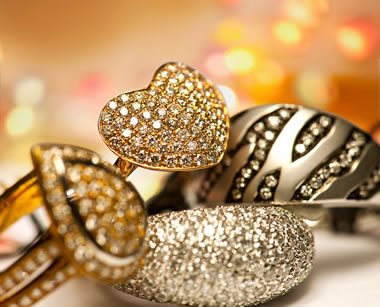
Argyle Diamond Jewelry: These pieces from the "Australian Colours" jewelry collection are covered with dozens of tiny Argyle diamonds. Each diamond has dozens of tiny facets. Dozens of diamonds, each with dozens of facets, produce an incredible scintillation when they are used in jewelry. Image Copyright 2016 Rio Tinto.
Brown Melee
Although most people think of diamonds as colorless gems, most natural diamonds are a faint to dark brown. For nearly 100 years, De Beers, the company that controlled the diamond industry, did not want brown diamonds in the gem diamond market. They ordered all brown diamonds that they mined or acquired to be sent for industrial use, mostly as abrasive granules. Because of this, brown diamonds had very little value. [1]
Then, in the 1980s, owners of the Argyle Mine in Australia had a lot of brown diamonds and a very bold idea. Instead of selling their brown diamonds to De Beers for a pittance, they shipped millions of them to India, where expert Indian cutters made them into melee-size gems - many as small as one point in weight! [2]
The tiny brown stones then entered the market in popular-priced jewelry. A dozen or so of these tiny brown gems brought an exciting scintillation to a piece of jewelry. A hundred of them in a pavé setting produced a spectacular result! (See accompanying image.) The attractive appearance and low cost of the jewelry was a great success, and it attracted a new group of buyers to the diamond jewelry market. [2]
Very few people noticed the brown color because the gems were so small and the scintillation so spectacular.
Today, brown diamonds are sold under trade names such as "chocolate diamonds," "champagne diamonds," and "cognac diamonds." Clever marketing, fresh designs, and low prices converted brown diamonds into a profitable product and a new jewelry category. [3]
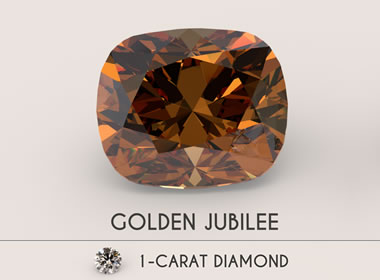
The Golden Jubilee Diamond: The Golden Jubilee is the world's largest faceted diamond. It is a yellowish brown diamond weighing 545.67 carats. It weighs 15.37 carats more than the Cullinan I, which was previously the world's largest faceted diamond. The Golden Jubilee was cut from a 755.5-carat piece of rough found at the Premier Mine in South Africa in 1986. Its "fire rose cushion cut" shape was designed by Gabriel Tolkowsky, who faceted the gem between 1988 and 1990. The specimen in the photo is a replica of the famous gem. A one-carat diamond is shown as a size comparison. Image copyright iStockphoto / DiamondGalaxy.
The Largest Faceted Diamond
The world's largest faceted diamond of any color is the 545.67-carat yellowish brown Golden Jubilee. It was cut from a 755.5-carat rough stone found by De Beers at the Premier Mine, in South Africa, in 1986. Gabriel Tolkowsky designed the "fire rose cushion cut" specifically for the gem and cut it between 1988 and 1990.
The diamond was exhibited at numerous locations by De Beers to showcase the largest faceted diamond in the world. In 1995, the Golden Jubilee was purchased by a group of Thai businessmen, who also exhibited the diamond at many locations. In 1996 it was given to King Bhumibol Adulyadej of Thailand as a gift from the people on the 50th anniversary of his coronation. [4] [5] This is when the diamond received its “Golden Jubilee” name. Today it is part of the Crown Jewels of Thailand.
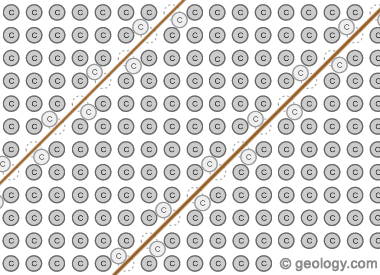
Graining in Brown Diamond: This illustration shows how plastic deformation causes brown color in diamond. In the illustration, each gray circle corresponds to a carbon atom in the regular repeating network of atoms in a diamond crystal. During its time in the Earth, the diamond is subjected to forces that cause planes of carbon atom displacement within the diamond crystal. This displacement changes how light passes through the crystal, and the planes selectively cause brown light to be transmitted. The planes are parallel in orientation, and if there are enough of them, the diamond will have a brown color to the observer. If the crystal is viewed through a microscope, looking parallel to the orientation of the planes, the edges of the planes will appear as parallel brown lines. They are called "brown graining" because the brown lines are reminiscent of wood grain.
The Origin of Brown Color
Many brown diamonds are thought to derive their brown color from being subjected to stress during their history in the Earth. This stress deforms the diamond crystal lattice, which produces a texture known as "graining" within the diamond crystal. This graining is sometimes visible during microscopic examination as a series of parallel to subparallel grain lines similar to the "grain" seen in a piece of wood. [3]
The deformed crystal lattice changes the way that light passes through the diamond. It causes the diamond crystal to absorb certain wavelengths of light and transmit other wavelengths. The visible light that reaches a human eye causes us to see these diamonds as "brown".
Brown graining is typical of brown diamonds from the Argyle mine in Australia. Some of the pink diamonds and red diamonds from Argyle receive their color from similar graining.
A Bit of Diamond History
In the late 1800s and early 1900s, enormous diamond discoveries in South Africa created a problem. So many diamonds were suddenly available that their free entry into the market would depress prices. De Beers gained nearly complete control of the global diamond supply and released diamonds into the market at a rate that maintained prices.
De Beers then stimulated demand through their "A Diamond Is Forever" marketing campaign. Many advertising experts believe that De Beers ran "the most successful ad campaign in the history of marketing." Growing demand and a tight control over supply made a lot of money for De Beers.
At that time - and continuing today - many people believe that the standard of diamond beauty and value is a clear, colorless stone. De Beers considered brown diamonds unsuitable for jewelry - but was that really true?
Early Brown Diamond Marketing
One of the first companies to market brown diamonds in the United States was Baumgold Brothers. The company was one of the most productive diamond manufacturing companies in the world in the first half of the 20th century and cut many world-famous diamonds, including the Kimberley, the North Star, the Transvaal Blue, the Transvaal, the Earth Star, and the Flaming Star.
In the 1950s and 1960s, they experimented with selling brown diamonds under a variety of enticing names, among which were amber, cappuccino, caramel, champagne, chocolate, cinnamon, coffee, cognac, espresso, mocha, and others. They had some success marketing these brown diamonds of subtle color differences under the names but eventually moved on to other business opportunities. [6]
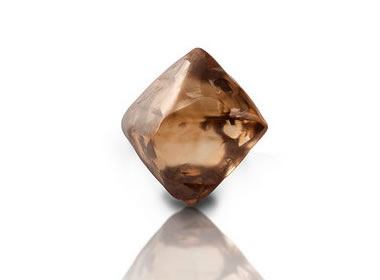
Brown Diamond Crystal: A brown diamond crystal of 8.72 carats produced from the Argyle Mine in Australia. This rough is expected to yield a faceted brown diamond that earns a "Fancy" color grade on the GIA colored diamond grading scale. [1] Image Copyright 2016 Rio Tinto.
Brown Diamonds from Argyle
In the mid-1980s the Argyle Mine in the East Kimberley region of Western Australia began producing diamonds. It quickly became the largest diamond producer in the world on the basis of carat weight.
A very small percentage of the rough diamonds mined at Argyle could be cut into stones on the D-to-Z color scale. The mine also produced a small number of colored diamonds in pink, red, blue, and violet colors. But, most of the rough coming out of their mine did not meet De Beers' definition of "gem quality." Why? They were brown!
About 80% of the Argyle rough was brown, under 0.1 carat in size, and most stones had clarity problems. De Beers, the company who held a near-monopoly on diamond rough at that time, was only willing to pay an industrial-grade price for these diamonds.
Managers at Argyle stopped selling their diamonds to De Beers. They decided to sell their colorless diamonds and fancy-colored diamonds themselves. And, they sent their brown rough to India where highly skilled but low-cost workers cut it into tiny round brilliant diamonds. Many of these tiny gems were as small as 0.01 or 0.02 carats.
The brown color of the rough was almost imperceptible when cut into tiny gems - and dozens of those tiny gems could be set in a single piece of jewelry. The jewelry was inexpensive, but hundreds of light-reflecting facets in each piece produced a wonderful scintillation that many people enjoyed.
Argyle had turned a rejected product into a new and profitable niche in the diamond jewelry market. [2]

Brown Diamond Crystal: A rough brown diamond exhibiting an octahedral crystal form and a color typical of the Argyle Mine. Crystal is approximately one centimeter from the top termination to bottom. Specimen and photo by Arkenstone / www.iRocks.com.
Champagne and Cognac Diamonds?
The brown diamonds from the Argyle mine were given interesting names. These names were inspired by modifying hues of yellow or red that accent the appearance of the brown diamond. Light yellow-brown to golden-brown stones were called "champagne diamonds." Darker orange-brown and reddish brown stones were called "cognac diamonds".
Fresh, attractive, scintillating, and inexpensive, the Argyle diamond jewelry immediately appealed to many customers. Brown can be beautiful, and people purchased these stones because they liked them!
When life gives you lemons, make lemonade. When a mine gives you brown diamonds, you can make your choice of champagne, cognac, or chocolate. :-)

Siberian Brown Diamond: An uncut brown diamond crystal from Eastern Siberia, Russia exhibiting a dodecahedral crystal form and a silky but adamantine luster. Crystal is approximately 1.2 x 1.2 x 0.8 centimeters in size. Specimen and photo by Arkenstone / www.iRocks.com.
What Are Chocolate Diamonds?
In 2000, Le Vian, a jewelry design and manufacturing company, began acquiring Argyle diamonds in a limited range of brown colors. They called these gems "Chocolate Diamonds ®" and trademarked the name. Many of their "chocolate diamonds" were set in jewelry made from "Strawberry Gold ®" - a Le Vian gold alloy with a reddish color.
Thirty years earlier these "Chocolate Diamonds ®" would have been crushed into abrasive granules. Now, they had become a diamond jewelry trademark. Today, the words "chocolate diamonds" are now used generically by people who are looking for brown diamonds. [6] The name has been that successful.

Sizing Diamonds: Sizing diamonds from the Rio Tinto Bunder prospect by sieving. Image Copyright 2016 Rio Tinto.
Color Grades for Brown Diamonds
Brown diamonds are recognized in the famous D-to-Z diamond color grading scale developed by the Gemological Institute of America. Diamonds graded K to M with a distinct brown color are given a letter grade and termed "Faint brown". Those graded N to R receive a letter grade and the term "Very Light brown", and those graded S to Z receive a letter grade and the term "Light brown". [3]
Brown diamonds on the D-to-Z scale will generally sell for prices that are less than similarly graded diamonds without the brown color. In addition, the color was graded with the diamond positioned in the table-down position - so the color grade is a bodycolor rather than the face-up impression of the color.
Beyond the D-to-Z scale, diamonds with a distinct brown color might earn a grade of Fancy Light, Fancy, Fancy Intense, Fancy Dark, Fancy Deep, or Fancy Vivid, depending upon their appearance determined by the combined effect of hue, tone, and saturation. All of these "Fancy" color grades are determined by examining the gem in the face-up position. That makes the color assessment more similar to what a buyer will experience if the diamond is displayed or used in jewelry.
Uses of Brown Diamonds
Brown diamonds have uses beyond those in the contemporary women's jewelry described above. The history of brown diamonds being used as a gem goes back for nearly 2000 years, perhaps longer. Rings set with brown diamond crystals were being made by Roman artists between the first and third centuries C.E. [1] At that time methods for cutting and polishing diamonds had not been developed, but setting a natural crystal in a ring was a good alternative.
For the company's first 100 years, De Beers considered brown diamonds to be unsuitable for use in jewelry. Brown diamonds mined by the company or purchased from other producers were sent for industrial use. Many of them were crushed and used to make industrial abrasive granules. The granules were used to line the cutting surfaces on diamond drill bits, grinding wheels, abrasive papers, saw blades and other tools.
Some of the larger brown diamonds, free of fractures and inclusions that would lower their durability, were used to manufacture specialty bearings or wear-resistant parts. Others were fashioned into dies used to manufacture wire. [1]
Today, brown diamonds from Argyle and other mines are appreciated around the world, especially in the United States fashion jewelry market. They are also gaining popularity among rising middle-class consumers in China and India. [2]
Brown Diamonds for Men!
Brown diamonds have become especially popular in men's rings, cufflinks, earrings, watches, and other jewelry. Brown is a masculine color. Brown diamonds are attractive and cost less than colorless diamonds of the same size and clarity. Brown diamonds make great sense for men in many ways.
| Brown Diamond Information |
|
[1] The Nature of Diamonds by George E. Harlow, Cambridge University Press, 1997, 288 pages, ISBN-10 0521629357.
[2] Diamonds Are for Everyone: Article that once appeared on the Rio Tinto website, now hosted on the Internet Archive. [3] Bravo for Brown Diamonds: Article on the Gemological Institute of America website, accessed November 2018. [4] Golden Jubilee, an article that once appeared on the De Beers Group website but has been hosted on the Internet Archive since June 13, 2008. [5] The Nature of Color in Diamonds, by Emmanuel Fritsch; Chapter 2, in, The Nature of Diamonds, edited by George E. Harlow; published by Cambridge University Press, pages 23 to 47, 1998. [6] Rise From the Rough: The Growing Demands on the Brown Diamond Market: Journal of Brand Strategy, Volume 3, Number 4, pages 332 to 338, Winter 2014-2015. |
Brown Diamond Treatments
Brown diamonds are sometimes treated, but these treatments are usually done to convert them into diamonds of other colors. Brown diamonds owe their brown color to lattice imperfections thought to be a result of geologic forces applied to the diamonds at some time during their long history.
High-temperature, high-pressure treatments have been used to convert many brown diamonds into attractive yellow or colorless diamonds. These diamonds are more valuable than brown but less valuable than natural, untreated diamonds of similar color and quality.
| More Gemstones |
 |
Diamond |
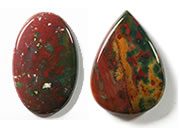 |
Bloodstone |
 |
Blue Gemstones |
 |
Tourmaline |
 |
Birthstones |
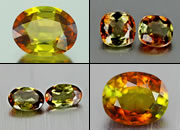 |
Andalusite |
 |
Rock Tumblers |
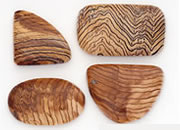 |
Opalized Wood |

Find Other Topics on Geology.com:

|

| ||

|

| ||

|

| ||

|

|

